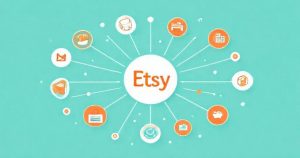In the dynamic world of online retail, Etsy sellers constantly seek methods to refine their operations, amplify efficiency, and foster sustainable growth. Strategic Etsy integrations emerge as powerful tools, designed to automate routine tasks, synchronize data across platforms, and provide deeper insights into business performance. These solutions extend beyond Etsy’s native capabilities, offering a tailored approach to managing everything from inventory and shipping to accounting and marketing. Understanding the diverse range of available integrations and their potential impact is crucial for any seller aiming to elevate their entrepreneurial journey and dedicate more time to creativity and product development.
Understanding Etsy Integrations: A Foundational Overview
Etsy integrations refer to third-party applications or services that connect directly with an Etsy shop’s data and functionalities through its API (Application Programming Interface). These connections allow information to flow seamlessly between Etsy and external systems, eliminating the need for manual data entry and reducing the likelihood of errors. The core benefit lies in automation, which frees up valuable time for sellers. By streamlining various business processes, integrations enable sellers to focus on product creation, customer engagement, and strategic planning rather than repetitive administrative tasks.
The spectrum of Etsy integrations is broad, encompassing solutions for nearly every aspect of an e-commerce business. From robust inventory management systems that track stock levels across multiple sales channels to advanced shipping tools that generate labels and manage tracking, these integrations are designed to empower sellers. They cater to a wide array of needs, whether a seller is just starting and requires basic organizational tools or managing a high-volume operation that demands sophisticated, multi-faceted solutions. Recognizing which areas of a business can benefit most from automation is the first step toward effective integration.
Key Integration Categories for Etsy Sellers
To effectively enhance shop management, sellers can explore several critical integration categories, each addressing specific operational challenges and opportunities for efficiency. These categories are fundamental to building a robust and scalable e-commerce infrastructure. Understanding the unique contributions of each type allows sellers to strategically select tools that align with their business model and growth aspirations. Each category offers distinct advantages, contributing to a more cohesive and productive selling environment.
Inventory Management Integrations for Etsy
Maintaining accurate inventory levels is paramount for any Etsy seller, especially those operating across multiple sales channels. Inventory management integrations provide a centralized hub to track product stock, update quantities in real-time, and prevent frustrating overselling situations. These tools often feature multi-channel syncing capabilities, ensuring that when an item sells on Etsy, its stock count is automatically adjusted on other platforms. This automation is vital for maintaining customer satisfaction and operational integrity.
Furthermore, these systems can assist with managing product variations, bundles, and kits, simplifying complex inventory structures. Some advanced solutions offer predictive analytics, helping sellers anticipate demand and optimize purchasing decisions. By minimizing manual stock checks and discrepancies, sellers can significantly reduce the time spent on inventory oversight, allowing them to focus more on sourcing, creation, and marketing. The investment in such an integration often translates directly into fewer operational headaches and improved financial performance.
Shipping and Fulfillment Integrations for Etsy Shops
Efficient shipping is a cornerstone of a positive customer experience and a major time consumer for Etsy sellers. Shipping and fulfillment integrations automate various stages of the shipping process, from generating shipping labels and tracking numbers to managing carrier pickups. These platforms often provide access to discounted shipping rates, which can lead to considerable cost savings, especially for businesses with high order volumes. Integration with major carriers ensures a seamless flow of information and updates.
Beyond label creation, many shipping solutions offer features like batch label printing, order consolidation, and automated customer notifications. This level of automation ensures that orders are processed quickly and accurately, enhancing customer satisfaction through timely delivery and transparent tracking. By reducing manual entry and errors associated with shipping logistics, sellers can reclaim hours each week, redirecting their energy towards creative endeavors and business development. Such integrations are particularly valuable for sellers looking to scale their operations.
Accounting and Financial Integrations: Streamlining Etsy Books
Managing finances and taxes can be one of the most daunting aspects of running an Etsy shop. Accounting integrations bridge the gap between Etsy sales data and professional accounting software, automating the recording of transactions, expenses, and revenue. This connectivity simplifies bookkeeping, tax preparation, and financial reporting, ensuring accuracy and compliance. Sellers can easily track income, categorize expenses, and generate detailed financial statements without extensive manual data entry.
These tools are invaluable for understanding the true financial health of a business, offering insights into profitability, cash flow, and areas for potential cost reduction. By eliminating the need to manually export and import sales data, sellers save significant time and reduce the risk of errors that could impact tax filings. From basic expense tracking to comprehensive financial analysis, accounting integrations provide the clarity needed for informed decision-making and strategic financial planning, empowering sellers to manage their money effectively.
Marketing and Customer Relationship Management (CRM) for Etsy
Engaging customers and effectively marketing products are vital for sustained growth on Etsy. Marketing and CRM integrations help sellers streamline communication, manage customer data, and execute targeted promotional campaigns. These tools can connect Etsy customer lists with email marketing platforms, enabling automated email sequences for abandoned carts, post-purchase follow-ups, or promotional announcements. Social media scheduling integrations also ensure consistent brand presence across various platforms.
CRM functionalities allow sellers to centralize customer information, track interactions, and personalize customer service. This leads to stronger customer relationships, increased loyalty, and repeat business. By automating elements of marketing and customer outreach, sellers can maintain a consistent brand voice and engage with their audience more effectively without consuming excessive time. These integrations are instrumental in building a loyal customer base and expanding market reach beyond the Etsy platform itself.
Choosing the Right Etsy Integrations: Factors to Consider
Selecting the most suitable Etsy integrations requires careful consideration of several key factors to ensure they align with specific business needs and goals. The decision should not be rushed but rather approached strategically, evaluating both immediate requirements and long-term aspirations. A well-chosen integration can significantly enhance efficiency, while a mismatched one might create more complexities. Understanding these critical elements helps in making informed choices that truly benefit the shop.
Important considerations include the scalability of the integration, ensuring it can grow with the business without requiring frequent changes. Cost is another vital factor, ranging from free basic tools to tiered subscription models; sellers must evaluate the return on investment. Features offered should directly address identified pain points and desired improvements. Furthermore, ease of use, robust customer support, and compatibility with existing workflows are crucial for seamless adoption and effective utilization of any new integration solution.
Implementing Etsy Integrations: A Step-by-Step Guide
Successfully integrating new tools with an Etsy shop involves a methodical approach to minimize disruption and maximize benefits. A structured implementation process ensures that the transition is smooth and that the chosen solutions are fully optimized for the business. Rushing this stage can lead to unforeseen issues and reduce the overall effectiveness of the integration. Careful planning and execution are key to unlocking the full potential of any new system.
Begin by planning the integration, clearly defining objectives and expected outcomes. Next, test the integration thoroughly in a controlled environment, if possible, to identify and resolve any potential conflicts or issues before going live. A phased rollout can be beneficial, gradually introducing the new system to different aspects of the business. Finally, continuously monitor performance and gather feedback to make necessary adjustments, ensuring the integration consistently meets the evolving needs of the Etsy shop. Regular review and optimization are essential for long-term success.
Maximizing Profitability with Etsy Integrations: Strategic Insights
The ultimate goal of adopting Etsy integrations extends beyond mere efficiency; it is about significantly impacting the shop’s profitability. Strategic deployment of these tools can directly lead to reduced operational costs, increased sales, and improved customer retention, all contributing to a healthier bottom line. Understanding how integrations create this financial uplift empowers sellers to make more informed investment decisions and prioritize solutions with the greatest economic return.
Integrations contribute to profitability by saving valuable time, which translates directly into reduced labor costs or allows for more focus on high-value activities. They minimize errors, preventing costly mistakes in inventory, shipping, or accounting. Better data insights from integrated tools can inform pricing strategies, identify best-selling products, and optimize marketing spend. Furthermore, enhanced customer satisfaction through efficient service and accurate order fulfillment often leads to repeat business and positive reviews, boosting long-term revenue and solidifying brand reputation.
Conclusion
Strategic Etsy integrations offer a transformative pathway for sellers to optimize their operations, enhance efficiency, and drive sustainable growth. By automating critical business processes—from inventory management and shipping to accounting and marketing—sellers can reclaim valuable time, reduce errors, and gain deeper insights into their performance. The careful selection and methodical implementation of these powerful tools enable a more streamlined, professional, and profitable Etsy shop. Embracing the right integration solutions is not merely about adopting technology; it is about strategically investing in the future success and scalability of an artisanal business.






